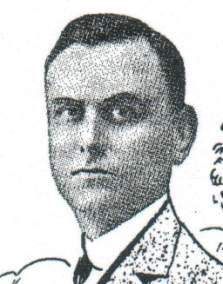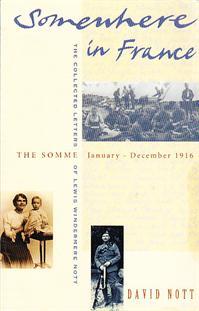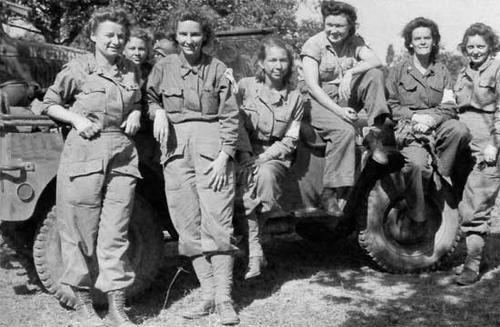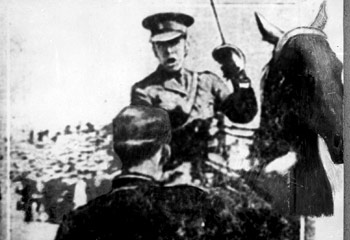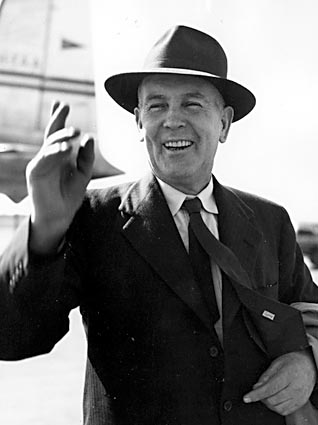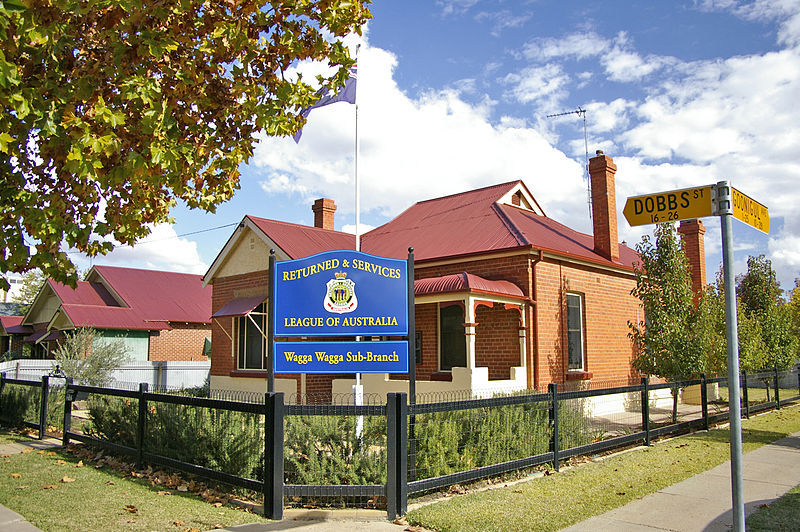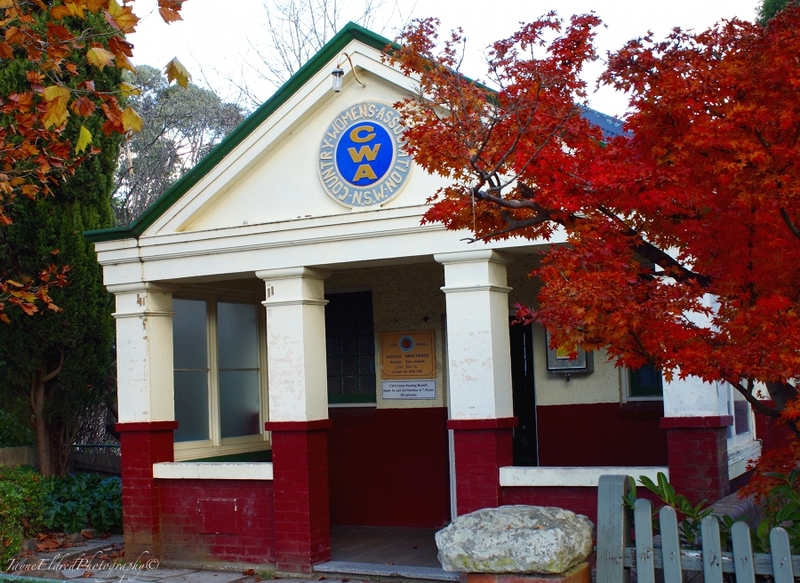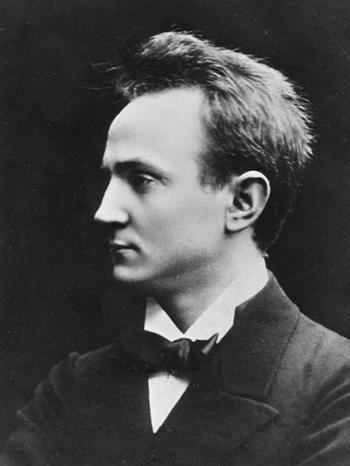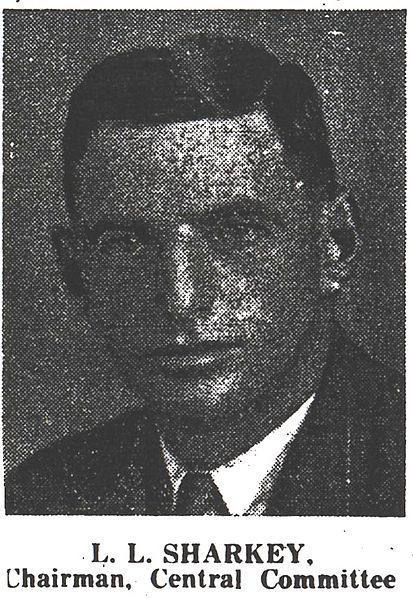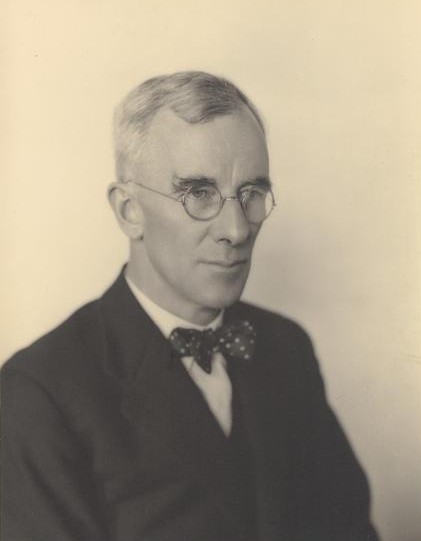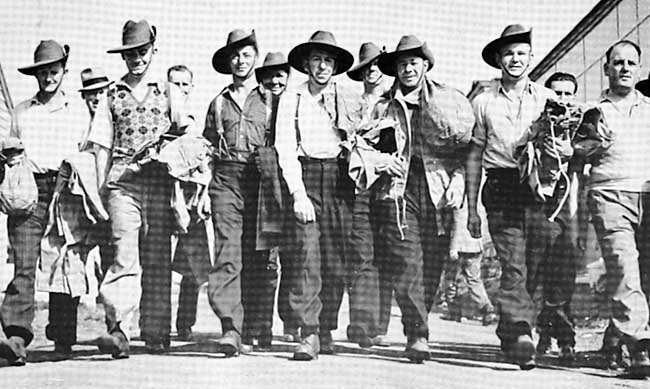We have already seen the accomplishments of the Australia-Finland Assistance Organisation in the substantial volumes of food, material assistance and fund-raising that was generated by the many thousands of members of this Australian-wide organization that seemingly sprang into being overnight. We will also in the near future look at the political pressure that this Organisation exerted on the Australian Government such that a large group of volunteers was actively supported in their efforts to travel to Finland and fight.
However, despite appearance, it was not the case that this Organisation sprang up spontaneously – the Organisation itself was the result of some solid prepatory groundwork which had taken place after the arrival in Sydney of the Valtioneuvoston Tiedotuskeskus team members but before the Winter War actually broke out. One of the early steps taken by the Finnish Consul, Paavo Simelius, in mid-1939, after receiving the first official communications that all was not well, had been to gather together the Executive Board of the Finnish Society of Sydney at his home and review with them what could be done.
There was very little that Simelius could do in the way of harnessing Australian political support for Finland – Finland itself was not an unknown quantity, but it was, as a country, by and large irrelevant to Australia and to Australian interests. Simelius certainly did his best, meeting with the Australian Minister of Foreign Affairs but receiving only a non-committal response. The small Australian-Finnish community began to do what little they could, largely through the raising of funds from Society activities. In addition, Nestori Karhula, a former officer in the Finnish Army began to put together a list of Australian Finns who would, if necessary, be willing, able and suitable to travel to Finland to join the Finnish Army. The Finnish Consulate in Sydney made a request to the Australian government to obtain the necessary permissions for collection of funds for Finland and in this they did receive an immediate affirmative answer, according to which the permit was issued for fund-raising for Finland “non-military purposes”.
Consul Simelius had already, on being advised that the Valtioneuvoston Tiedotuskeskus Team was en-route, arranged for the rental of office space with the limited discretionary funding available and Pastor Hytönen was appointed office manager and delegated the task of setting up office facilities, assisted by Mrs. Mimmi Tuomi and a number of other volunteers. Real progress however began to be made with the arrival of the Valtioneuvoston Tiedotuskeskus team in Sydney in early November 1939. one of their first meetings had been with the Executive Board of the Finnish Society – which at this time consisted of James Aalto (Chairman), clearest Kari Vice Chairman, Johan Kaasalainen (Secretary), John Partanen (Deputy Secretary) and Vilho Pullinen (Treasurer). James Aalto later recounted how Consul Simelius called up each of the Board members and asked them to come to an urgent meeting at his home where they met the Valtioneuvoston Tiedotuskeskus team, who described what was at stake and what their plans consisted of.
The members of the Board were astonished and pleased to meet again the Rev. Kurkiala, whom they knew well from earlier years. Members of the Board and Consul Simelius made numerous suggestions which the Team added in to their plans. The objective of the Valtioneuvoston Tiedotuskeskus team was to establish multiple approaches to the gaining of assistance for Finland in the event of a war with the USSR – by garnering official Australian government support, gaining wide-spread popular support via the news media, raising substantial funds through private and public fund-raising, gaining approval for the purchase of military and non-military materials and lastly to, if possible, negotiate the dispatch of Australian volunteers to assist in the war that was looking more and more likely.
In all of these approaches, it would be necessary to both establish a close relationship with Australian politicians the government and also to move well beyond the small Finnish Society and tap into mainstream Australia – to reach out to the man and woman in the street and involve them in Finland’s struggle at many levels. That this was done so successfully, and in so many countries around the world, speaks highly of the abilities of the men and women of the Valtioneuvoston Tiedotuskeskus teams who were plucked from their day-to-day lives in Finland and dispatched around the world – and for many of these men and women, it would be their first trip outside of Finland. Finland would own much to the way in which these men and women persevered and succeeded so admirably.
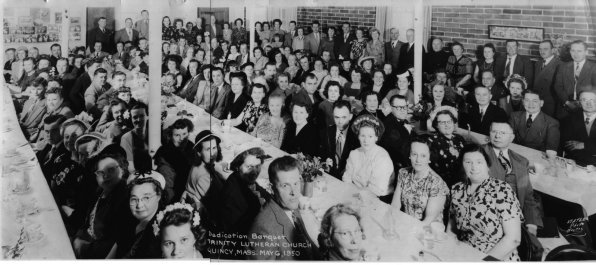
One of the first acts of the Sydney Valtioneuvoston Tiedotuskeskus Team – a dinner with the Finnish Society of Sydney where the Team introduced themselves and briefed the local Finnish community on their mission if the war that was expected actually broke out….early November 1939
In all of this, it was first necessary to secure the whole-hearted support of the local Finnish community as these would be the men and women on whom the small Valtioneuvoston Tiedotuskeskus Team would rely on for much of the drudgery – the answering of phones, mailing of letters, all the day to day administrative work that would be necessary. Meanwhile the new Finnish Consul, Paavo Simelius had been working non-stop to secure introductions for the 20 man Valtioneuvoston Tiedotuskeskus Team, some of whom were in turn working furiously with Australian journalists and advertising companies to put out material supportive of Finland.
Elsewhere, members of the team, including the Rev. Kurkiala and Jorma Pohjanpalo were establishing their own contacts in the religious, political and business fields. Simelius had been successful in securing an appointment with the Prime Minister, Robert Menzies, in mid-November 1939. Menzies was non-committal at this time, advising Simelius that if Finland was attacked, there would be little that Australia could do beyond providing moral support. However, Simelius did gain permission for the small Purchasing Team to place orders with Australian manufacturers for non-weapons related orders such as clothing and food. In addition, Simelius gained Menzie’s blessing for a “large” fund-raising and publicity campaign to support Finland in the event of a war with the USSR. These approvals were communicated officially and in writing to the Finnish Consulate in Sydney from the Prime Minister’s Office.
For Simelius and the Valtioneuvoston Tiedotuskeskus Team this was a major coup. They had the approvals they needed and much of the legwork had already been done. Orders were placed immediately with a number of manufacturers and stock agents, the results of which we have already covered. With regards to a “large” fund-raising and publicity campaign to support Finland in the event of a war with the USSR, the Valtioneuvoston Tiedotuskeskus Team and the Re. Kurkiala had already done much legwork prior to securing approval from the Government. Chief among their accomplishments had been the preparatory work needed to set up a viable and effective “Assistance” Organisation.
In this, the Rev. Kurkiala had achieved a notable success in securing the wholehearted commitment of a well-known Australian politician and organizer, Colonel Eric Campbell, while Consul Simelius had been in discussions with Dr. Lewis Windermere Nott, an Australian Dr., politician and, in 1939, a Member of the Council administering the Australian Capital Territory (within which Canberra is located). Colonel Eric Campbell, Dr Lewis Windermere Nott and the Rev. Kurkiala would, on 1 December 1939, become the joint Founders of the Australian Finland Assistance Organisation. Before we delve into the Australian Finland Assistance Organisation, a quick look at these two Australians is in order.
Dr Lewis Windermere Nott
Lewis Windermere Nott (12 February 1886 – 27 October 1951) was an Australian politician, medical practitioner and hospital superintendent. He was born at Windermere, a sugar-plantation located near Bundaberg in Queensland and was educated at Maryborough Grammar School, after which he studied assaying at the School of Mines and Industries, Ballarat, Victoria. He subsequently completed a medical degree at the University of Sydney.
In 1913, he married Doris Ashbury in Sydney. The newly-wed couple travelled to Scotland where he continued studying medicine at the Royal College of Surgeons of Edinburgh, the Royal College of Physicians of Edinburgh, and the Royal College of Physicians and Surgeons of Glasgow. At the outbreak of World War One he enlisted in the Royal Scots as a Captain and was made adjutant. In 1916 he was wounded and twice mentioned in dispatches. His affectionate letters to his wife, describing conditions in the field, were edited by his son David and published as “Somewhere in France” (Sydney, 1996). He then resigned his commission and resumed his medical training in December 1916. On graduation in 1918 he joined the Royal Army Medical Corps.
Nott returned to Australia, took part in the campaign against hookworm and was then appointed medical superintendent of the Mackay District Hospital. From 1924 to 1927 he was Mayor of Mackay. In 1925 he won a seat in the Australian Federal Parliament for the Nationalist Party after unexpectedly defeating the Australian Labor Party candidate Ted Theodore, who had resigned as Premier of Queensland in order to enter federal politics. In 1928 Nott lost the seat to the Labor candidate, after which he ran unsuccessfully in North Sydney (1929) and Calare (1934).
Nott moved to Canberra in 1927, the year that it became the national capital. In 1929 he was appointed Medical Superintendent of the Canberra Hospital and held this position until 1934 and again from 1941 to 1949. He campaigned for the creation of an advisory council for the Federal Capital Territory (in 1938 renamed the Australian Capital Territory, ACT) and was elected as a member of the council from 1935 to 1949. When approached by Consul Simelius, Dr. was immediately sympathetic to the Finnish cause and agreed to take a leading role in the Australia-Finland Assistance Organisation.
An inveterate politician, he was a well-known figure in Australia and an effective and fiery public speaker. His credentials as both a soldier and a Doctor were impeccable. From the start, Dr. Nott would take a leading role in the Australia-Finland Assistance Organisation and would also, as a medical practitioner and former soldier, organize a field hospital for the Commonwealth Division. Immediately on agreeing to co-found the Organisation, Nott wrote a series of letters to the Prime Minister, Australian politicians, Branches of the Nationalist Party, numerous Australian organizations such as the Country Womens Association, the Returned Services League and others and to the daily press advising them of the upcoming establishment of the Organisation, its intentions and asking for their support.
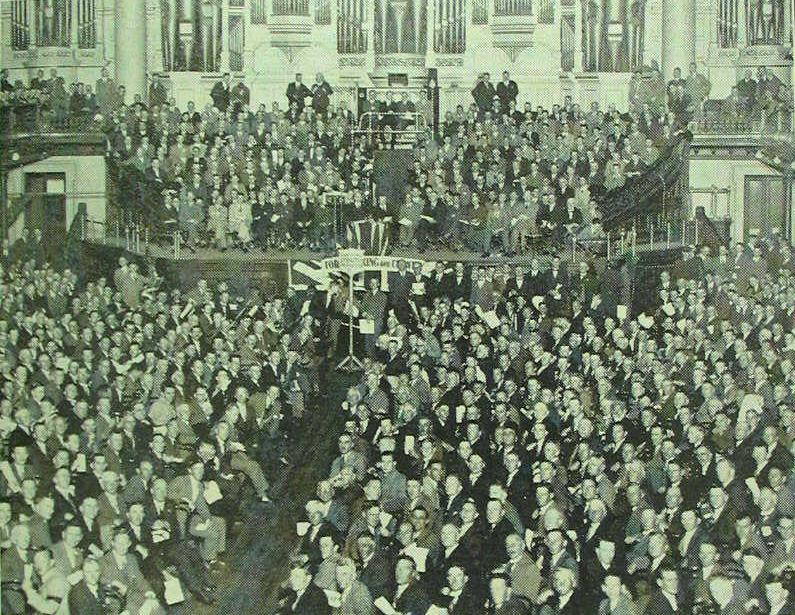
The inaugural meeting of the Australian Finland Assistance Organization in Sydney on the 3rd of December 1939 was packed to capacity.
Two days after the USSR attacked Finland, the Australia-Finland Assistance Organisation held its inaugural meeting in Sydney. The Hall selected was packed to capacity, with Dr. Nott receiving a standing ovation to his speech, which along with others was reported in full in newspapers across Australian on the morning of the 4th of December 1939. Accompanying the reports on the meeting was an open plea from Dr. Nott to the Government for the whether the Prime Minister to give his imprimatur to a voluntary ambulance unit and field hospital to be dispatched to Finland immediately. There were, Nott said, many professional men like himself, who though medically fit, and with excellent civil and military records, were not allowed to go overseas with the second A.I.F. (Australian Imperial Forces).
Nott pointed out that Australia’s fate was inextricably bound up with that of Finland, and Finland’s “gallant resistance” was an inspiration to democracy at its intelligent best. There was, Nott repeated, not one obstacle in the path of staffing the Unit at once, but the question of transport, stores and upkeep was the major consideration and Nott could only visualize the unit succeeding over an extended period of time by a combination of government and voluntary assistance.
Nott and the organization were almost immediately inundated by an overwhelming response from surgeons, specialists, dentists and nurses from all states, even as far afield as North Queensland, South Australia and Western Australia. Leaving aside for a moment the success of the Australia-Finland Assistance Organisation, Nott would be appointed to command the Medical Units made up of volunteers that Australia would dispatch to Finland. As the volunteers grew into what would be the Commonwealth Division, Dr. Nott was appointed to command of the Divisional medical units, a command position he would accept and hold until the end of the Winter War, after which he would return to Australia and his former positions as Medical Superintendant and Councilor.
In Finland, Dr. Nott was instrumental in introducing mobile medical units along the lines developed by the Canadian Dr. Norman Bethune in the Spanish Civil War. A frequent cause of death on the battlefield is medical shock brought on by loss of blood. A casualty whose wounds do not appear life-threatening suddenly dies. Bethune had conceived the idea of administering blood transfusions on the spot and developed the world’s first mobile medical unit. The unit contained dressings for 500 wounds, and enough supplies, medicine and equipment for 100 battlefield emergency operations. Bethune organized a service to collect blood from donors and deliver it to the battlefront, thereby saving countless lives. Nott introduced similar units, Mobile Battalion Aid Stations, to Finland, designed to get experienced personnel closer to the front, so that the wounded could be treated sooner and with greater success.
The system that Dr. Nott designed was based on immediate aid from a unit medic, after which the casualty was routed to a near-frontline Battalion Aid Station for emergency stabilizing surgery, after which the casualty was evacuated to a Field Hospital for more extensive treatment. This proved to be highly successful and as these innovations percolated outwards through the Maavoimat medical units, during the last months of the Winter War, a seriously wounded soldier who made it to a Battalion Aid Station alive had a greater than 87% chance of survival once he received treatment. The ability of the Battalion Aid Station’s (and in some cases even Company Medics) to perform immediate blood transfusions on the spot proved of perhaps the most benefit – where blood transfusions could be administered on the frontline within minutes, survivability increased to 97% where the casualty was wounded rather than killed outright. This had a significant impact on morale – knowing that if one was wounded, one stood a high chance of surviving made a great deal of difference to the individual soldier’s mindset in combat.
Photo at Left: A group of Army Nurses of the Commonwealth Division Field Hospital (400-bed capacity, commanded by Lt-Col. Dr. Lewis W. Nott) posing in front of a US-supplied 1/4-Ton Truck. The Field Hospital arrived in Finland with the Australian volunteers and would remain until November 1940, before transferring to the UK and then to the Middle East. Note that by later summer 1940, when this photo was taken, the Australian Nurses are wearing military-style trousers and shirts. This was another innovation introduced by Dr. Nott for practical reasons – working as nurses in the field, wearing military-style trousers and shirts for women proved to be a significant benefit. Although this was a change that would percolate only slowly, by 1944 some Maavoimat medical units would make similar changes, issuing military-style trousers and shirts to Lotta’s.
In 1949, Nott was elected as an independent as the first representative of the Division of Australian Capital Territory in the Federal Parliament, where he had unlimited speaking rights but could only vote on matters affecting the ACT. He was one of only five people who have represented more than one state or territory in the House of Representatives, and the only one to represent both a state and a territory. He was defeated by the Labor candidate Jim Fraser in the 1951 election. He was subsequently appointed as a medical officer in Victoria, but collapsed on the flight to Melbourne and died the next day of leukemia in the Royal Melbourne Hospital. Nott is buried in the Presbyterian Section of the Woden Cemetery, Canberra.
Dr. Nott’s funeral was no simple family ceremony. Representatives of almost every phase of his life paid their last respects at an impressive funeral service at St. Andrew’s Presbyterian Church in Canberra. Members of practically all public bodies in the A.C.T. attended, crowding into the main church and the Warriors Chapel, the nave and overflowing outside, where approximately 200 persons listened to the service through amplifiers. The President of the Senate, Senator E. W. Mattner, the Speaker of the House of Representatives, Mr. A. G. Cameron and the Minister for the Interior, Mr. W. S. Kent Hughes, who represented the Prime Minister, were present. The Opposition was represented by Messrs. A. A. Calwell and J. R. Fraser. Among many members of Parliament present were Mr. W. M. Hughes, whom Dr. Nott opposed in the 1929 election for North Sydney, and Senator W. J. Cooper. Both were members of Parliament from 1925 to 1928, when Dr. Nott was member for Herbert.
Members of the diplomatic corps who attended included the High Commissioner for Ceylon, Mr. J. Aubrey Martensz, the Minister for Ireland, Dr. T. J. Kiernan, Mr. J. A. M. Marjoribanks, representing the Acting U.K. High Commissioner, Mr. Paavo Simelius, the Consul for Finland and Mrs. N. M. Lifanov, wife of the Soviet Ambassador. Many of the congregation had taken their seats in the church almost an hour before the service was to begin.A large detachment of police attended the funeral. The church was almost full when Mrs. Nott arrived and, assisted by her son and daughters, placed a wreath of red roses at the head of the raised flag-draped oak casket. Wreaths from many other organisations lay at its foot. Mrs. Nott was obviously under great strain, but carried herself bravely. Among family mourners were the deceased’s cousins, Messrs. L. G. Priestley and R. G. Norris from Sydney. The service opened with a hymn of the family’s selection “Onward Christian Soldiers.”
The service was conducted by the Rev. Hector Harrison. In his panegyric, the Rev. Mr. Harrison said: “As we gather here this afternoon to pay our tribute of respect to the memory of Lewis Windermere Nott, there is common to each one of us a very real and unaffected sense of personal sorrow. And that sorrow is shared to the humblest in this fair city, by all classes, from the highest. During this past week we knew that we were losing a public figure who had brought much colour into the civic life of Canberra, and the best wishes of their many friends followed Dr. and Mrs Nott as they left us to live in Yallourn. But not for one moment did anyone dream that the city’s loss would deepen into grief through his untimely death. The shock of the dread news shivered through the community over the week-end in a manner which left many stunned and incredulous at the thought of this buoyant spirit being laid low in death.
There is a saying that God sometimes makes a man and then breaks the mould, so that the world never looks upon his like again. Many of us feel that the mould was broken when Dr. Nott was born. We cannot imagine another such as he appearing on the platform of public life in Canberra. To-day the wells of memory are stirred to their very depths as hundreds think of Dr. Nott’s life and work. There are some here today whose minds hark back to the grim, grey days of the depression years, when the Doctor was one of a group who battled to keep hope alive in the hearts of the despairing and who helped men, women and children with means of subsistence in the hour of their dire need. Others will remember the long fight that he waged for the representation of the Australian National Territory in Federal Parliament and of the reward which came to him when he took his seat as the first elected member for the Territory.
The memories of a great many more will fly back to the years when the Doctor gave added medicine of a merry heart to the prescribed treatment at the Canberra Community Hospital. And the aged will recall his continued advocacy for Eventide Homes to lighten the passage of their years. Further, hundreds of ex-servicemen will remember that there was one who understood them, because he too had lived and fought and suffered wounds amid the mud, blood and misery of those terrible Flander’s fields in the First World War as well as on the battlefields of Finland at the height of the Winter War, where he was instrumental in bringing aid and succor to the soldiers of Australia and of Finland. Dr. Nott touched life at so many points that one can only mention a few of his interests. In Parliament, on the Advisory Council, in the Returned Servicemen’s League and the Legacy Club, as founder of the Australia-Finland Assistance Organization, as a patron of the arts, and a lover of animals, his was an abounding life. All barriers of class or creed fell when he was about, and even those who opposed him in public life were quick to appreciate his good humour, ready wit and warm fellowship, for his heart was too big to allow differences to divide.
So he laboured on for the good of all to the very end. His only hate was a deep-rooted hatred of injustice, and his was a voice that was heard whenever Canberra residents desired to ventilate any grievance. But kindness, sympathy and gener- osity flowed from his colourful personality and radiated goodwill wherever he went. And the background of his public life was an ideal home where he could be rested and refreshed for the work he loved. To Mrs Nott, who shared in so many of the Doctor’s good works and to the members of the family we offer our deep sympathy and pray that the peace of God may abide in their hearts. So, in the ever-shadowing mystery of death, Lewis Windermere Nott has been taken. His name is written in the hearts of the people as well as on the records of the State. We give thanks for that best portion of a good man’s life, his little, nameless, unremembered acts of kindness and of love. We pray that others may follow the example of the one whose body we shall soon commit to the ground, and whose soul we commend to Him who gave it birth.”
The service concluded with the hymn “Be Still My Soul.” In an atmosphere intensified by the solemn Funeral March by Chopin, the pall-bearers bore the casket from the church, followed by the relatives of the deceased and official representatives. Preceded by three police motor cyclists and a floral float loaded with beautiful wreaths, the cortege started for the cemetery. The slow-moving procession was approximately one and a half miles long, the last vehicles leaving the church as the hearse passed the Prime Minister’s Lodge. It took the vehicles almost 20 minutes to pass a given point. At every street intersection, onlookers stood in silent reverence as the hearse passed. Windows at West Block and at Legations along State Circle were filled with spectators. A number of motorists who did not attend the church service joined the cortege.
Mrs Nott did not attend the graveside ceremony, at which approximately 500 persons were present. Ex-servicemen who had served with Dr. Nott in WW1 and in the Winter War in Finland marched in front of the hearse to the site. The acting president of the A.C.T. branch of the R.S.L. (Mr. H. Preston-Stanley) paid a short tribute to the work of the deceased in the Canberra community, following which the Finnish Consul, Mr. Paavo Simelius, paid a short tribute to Dr. Nott’s contribution to the freedom of Finland. As the service concluded with “The Last Post” and “Reveille,” played by Corporal N. Rundell, ex-servicemen comrades cast their Poppies of Remembrance into the grave, and the many dozens of wreaths were placed in position. They included wreaths from the Administrator, Sir John Northcott, the Deputy Prime Minister and Lady Fadden, from the Government and Army of Finland and from members of the diplomatic corps.
Together with dozens of wreaths from private families or individuals, were floral tributes from the Commonwealth Government, the President, members and officers of the Senate, from the County of Cumberland Kennel Association, the Goulburn Kennel Asosciation, the Victoria League in Canberra, the Canberra Ambulance Station, the Greek Community, the Transport Section of the Department of the Interior, the staff of the Parliamentary Refreshment Rooms, the Trades and Labour Council, the Canberra Technical College, Canberra Legacy Club and the Women’s Auxiliary, R.S.L. sub-branches in Canberra and Queanbeyan, the Canberra Hospital Auxiliary, the domestic staff of the Canberra Hospital, the Canberra Services Club, the Canberra Workmen’s Club, the Canberra Community Hospital Board, the Canberra Highland Society and Burns Club, the A.C.T. Advisory Council, the Liberal Party, the Legion of Ex-servicemen, the Ex-Navalmen’s Association, the Australia-Finland War Veterans Association, the Management and staff of 2CA, the Airforce Association, the nursing staff of the Canberra Community Hospital, the Canberra Guild of Archers, the staff of Hotel Kingston, the A.C.T. branch of the R.S.L., the Police Association, “The Canberra Times,” the A.C.T. division of the Australian Red Cross and many other organisations.
Colonel Eric Campbell
Eric Campbell (1893-1970), solicitor and leader of the New Guard movement, was born on 11 April 1893 at Young, New South Wales, fourth son of native-born parents Allan Campbell, solicitor, and his wife Florence Mary, née Russell. He was educated privately and was a cadet-member of the Coronation Contingent which visited England in 1911. While an articled clerk in his father’s law office, he was commissioned in 1914 in the volunteer Australian Field Artillery. In April 1916 he joined the Australian Imperial Force as a Lieutenant, was promoted Captain in May and Major next year. He served first in France with the 27th battery of the 7th A.F.A. From August 1917 until the Armistice he was with the 12th Australian (Army) Field Artillery Brigade, attached to General Headquarters, in Flanders, on the Somme, and in the final advance to the Hindenburg Line. He was gassed in November 1917, twice Mentioned in Dispatches in 1918, and was awarded the Distinguished Service Order in January 1919.
Campbell returned to Australia in February 1919, resumed his legal studies and was admitted as a Solicitor on 29 August 1919. Between 1920 and 1926 he was in partnership with S. G. Rowe, then established with his brother Campbell, Campbell & Campbell, a successful practice with a clientele of pastoralists, merchants, professional men and financial institutions. On 22 October 1924 he married Nancy Emma Browne (daughter of a grazier) at Memagong Station, near Young. In 1931 he was a reputable businessman living at Turramurra: a director of Australian Soaps Ltd, Discount and Finance Ltd and other companies, he belonged to the Imperial Service Club, the Union and New South Wales Clubs and Royal Sydney and Killara Golf Clubs; he was also a Freemason and a member of the Rotary Club of Sydney.
He was fond of tennis, gardening, surfing and motoring. Actively interested in the Militia, Campbell commanded the 9th Field Artillery Brigade in 1924 and was promoted Lieutenant-Colonel in 1925; he was transferred to the reserve in 1932. He turned to paramilitary activity in 1925 when, with Major John Scott, he recruited a secret force of 500 ex-officers to try to put down a seamen’s strike. In 1930 he became recruitment officer for an organisation run by (Sir) Robert Gillespie and (Sir) Philip Goldfinch, a secret vigilante group of businessmen, ex-officers and graziers alarmed by the Depression and the election of J. T. Lang’s Labor government; they were later known as the Old Guard.
At a meeting at the Imperial Service Club on 18 February 1931 Campbell, disappointed with the Old Guard, was the principal founder of the New Guard, which stressed loyalty to the throne and British Empire, and wanted “sane and honourable” government and the “abolition of machine politics”. Campbell saw patriotism as its key virtue. The New Guard aimed at uniting “all loyal citizens irrespective of creed, party, social or financial position”. Campbell organized the movement on military lines. With a peak membership of over 50,000 within Sydney alone, the New Guard rallied in public, broke up “Communist” meetings, drilled, vilified the Labor Party and demanded the deportation of Communists. There were other similar “radical conservative” movements in Australia – The “All for Australia League”, for example, which rapidly amassed a membership of 130,000 in New South Wales in 1931, similarly sought to unite the nation through appeals to patriotism and the national interest – rather more successfully than the “New Guard” as the “All for Australia League” was more in the political centre. (The “All for Australia League” was formed from defectors from the Australian Labour Party and dissident Nationalist Party members).
In March-May 1931 the League worked to establish a new party, the United Australia Party (UAP) from the merger ALP members, the Nationalists and anti-Labor citizens’ groups. Joseph Lyons, a former Labour Party member and ex-Premier of Tasmania was elected to the UAP leadership unopposed. Lyons announced the new opposition party arrangements in the Federal Parliament on 7 May 1931, to the accompaniment of vehement denunciations from his former ALP comrades. The Australian Labour Party government fell through the loss of a confidence motion on 25 November 1931, when UAP opposition and Lang Labor (another group of ALP defectors led by the NSW Premier) combined to defeat the Government. Parliament was then dissolved. In the subsequent general election on 19 December 1931, the ALP was bundled from office by an electorate battered by the depression, tired of ALP disunity and dissatisfied with government’s handling of the economy.
The UAP won an absolute majority and was able to form a government without having to rely on a coalition with the Country Party – the “other” conservative party – Lyons would become the Australian Prime Minister and would lead the UP to victory at the general elections on 15 September 1934, and 23 October 1937. At the October election the UAP lost its absolute majority and was forced to enter into coalition with the Country Party. Lyon, suffering from ill-health, would die of a heart attack in April 1939, to be replaced as Prime Minister by Robert Menzies).
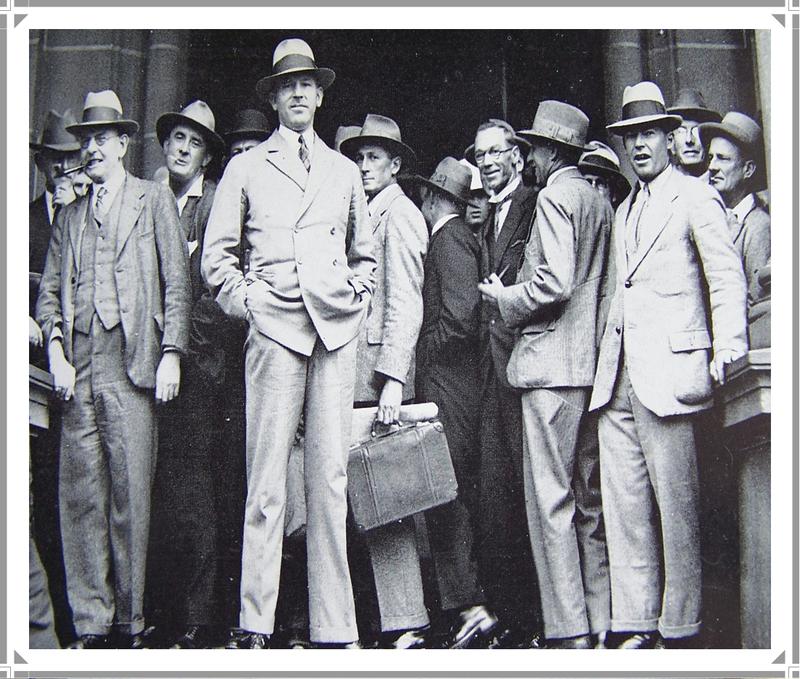
“…Campbell cut an impressive figure. He was a tall man of about forty years, broad shouldered and immaculately dressed in a double-breasted suit of fashionably light fabric. He was bald on top with the remaining fringe cropped short in military style. His face was surprisingly soft, his smile broad under a small brush-like moustache…”
The stated ideology of the New Guard was as a response to a perceived communist threat, one of the criticisms made of communism was that it took away individual freedom and was therefore antithetical to democracy. Many First World War veterans also viewed the Russian Bolshevik armistice and treaty with Germany as a betrayal and the revolution also went against the notion that subjects should remain loyal to their rulers. In any case, the agreement took Russia out of the war and allowed Germany to reallocate troops from the eastern front to the western front, making life more difficult for Australian troops.
The 1930s was also the decade of the Great Depression, which caused extreme hardship around the world. Financial hardship in Australia meant that the possibility of popular uprisings did not seem then as distant and remote as it would now. The name New Guard, then, suggested not only the idea of guarding a set of values but also of physically guarding the community, if necessary, against a communist revolution. While some historians have called the “New Guard” a fascist group, it’s a label that does not fit well. The movement arose at a time of great crisis. The world was in the midst of the Great Depression, with little sign of improvement. In Europe, Mussolini’s Fascists ruled Italy, Adolf Hitler was on the rise and would become Chancellor of Germany in January 1933, and Oswald Mosley’s British Union of Fascists had begun to attract attention.
Closer to home, an increasingly unpopular Labour government in New South Wales seemed to be moving further to the Left, with many of its members regarded by the conservatives as little more than Communists. The “New Guard” then was more of a radical conservative movement which emerged as a manifestation of the not unfounded fear of communism and of societal disruption. It certainly captured the attention of major newspapers and prominent politicians, as well as leading business and commercial associations.
The “New Guard” brought together thousands of discontented conservatives with a variety of ideas, both radical and traditional, on how to combat the Depression and the political Left. The New Guard began as a relatively peaceful outfit that used lawful means to advance its objectives and its platform was immediately popular with many First World War officers and veterans as well as others with conservative beliefs and attitudes. Numbers of Army officers were also members of the New Guard. The movements membership peaked in the early 1930’s, with an immediate threat within Australia being seen as Jack Lang’s Labor Party government of New South Wales, which was elected in October, 1930. Despite its appeal to unite the entire country, the New Guard’s membership was drawn very largely from the middle and upper-middle class. Its ranks overflowed with businessmen, professionals and farmers, with a smattering of journalists and teachers.
The average New Guardsman was white, male, in his mid-30s-to-late 40s, and had seen service during the Great War, often as an officer. Many were also involved in local government and in groups such as Rotary, local Chambers of Commerce and the Returned Soldiers’ Association. Many of the reform policies that Lang introduced during his term were not welcomed by the New Guard, in particular, his administration’s proposals to default on foreign debt repayments at the height of the Great Depression. In January 1932 Campbell asserted that Lang (the Labour Party Premier of New South Wales) would never open the Sydney Harbour Bridge, referred to him as a “tyrant and scoundrel”, and claimed to prefer Ebenezer (Lang’s bull) as Premier. Fined £2 at Central Police Court for using insulting language, Campbell successfully appealed. In the tense atmosphere of early 1932, rumours were rife that the New Guard was plotting a coup or the kidnapping of Lang; but Colonel Francis de Groot’s Harbour Bridge ribbon-cutting antics instead provided an anti-climatic ending to the episode.
Photo Left: Colonel Francis de Groot’s Harbour Bridge ribbon-cutting antics: A former officer who had served in the 15th Hussars in WW1, de Groot in 1932 was an antique dealer and furniture manufacturer in Sydney and a member of the New Guard. He became famous when on 19 March 1932, he upstaged Labour Party Premier of NSW, Jack Lang at the opening of the Sydney Harbour Bridge. He was not a member of the official party, but dressed in his military uniform he was able to blend in with other soldiers on horseback who were guarding the dignitaries. Lang was about to cut the ribbon to formally open the bridge, when de Groot rode forward, drew his ceremonial sword and, reaching down from his mount, flamboyantly slashed the ribbon, declaring the bridge open “in the name of the decent and respectable people of New South Wales.”
The Mayor of North Sydney, Alderman Primrose, an official participant at the opening ceremony, was also a member of the New Guard, but whether he was involved in planning de Groot’s act is unknown. De Groot was arrested, and his ceremonial sword confiscated but legal intervention by Superintendent Bill Mackay had him released. According to Mackay, De Groot would not be gaoled because he deemed him to be “clinically insane”. De Groot was later charged in the Supreme Court with carrying a cutting weapon, but when he was able to show that he was an officer in the Army Reserve and entitled to wear his uniform, which included his sword, this charge was dropped. Then he was charged with offensive behaviour. At the time this charge only applied to public property, and the law case then depended on whether the unopened bridge was public or private land. If private land, the charge had to fail, and if public, it meant that the road across the bridge was part of the King’s highway, and under common law any of His Majesty’s subjects was entitled to remove any obstacle, including ribbons, barring free progress along the King’s Highway.
In the end the court fined him £5 for trespassing. A large part of the plan to humiliate Lang was for all of de Groot’s acts to be legal. After the court case he sued for wrongful arrest on the grounds that a police officer had no right to arrest an officer of the Hussars. An out-of-court settlement was reached, and de Groot’s ceremonial sword was returned to him. De Groot managed to make a profit out of the whole charade. The horse ridden by de Groot at the opening ceremony was a 16.5-hand chestnut named “Mick”. The horse belonged to a Turramurra schoolgirl, Margo Wishart, and was borrowed by the leader of the New Guard, Eric Campbell, from her father. The horse, which was returned to its owner after de Groot’s escapade, lived to an old age.
However, in 1932 Lang was dismissed by the Governor-General and in the ensuing elections of 11 June 1932 Lang and the Australian Labor Party were defeated. With the easing of tension following Lang’s dismissal, members of the New Guard melted away along with the threat, and there was dissension among those remaining as Campbell grew more authoritarian and right wing, although he eschewed outright fascism after a visit to Germany and Italy. In 1933 he tried to take the remnant of the New Guard into party politics as a right-of-centre political party and formed the Centre Movement, but was defeated for Lane Cove at the 1935 State election. Many former members of the New Guard subsequently played a role in the more traditional conservative political parties.
In 1938 Campbell was charged with conspiracy to pervert the course of justice and to cheat and defraud Du Menier Laboratories Ltd, a subsidiary of Australian Soaps Ltd, of which he was chairman. He was acquitted. Next year, arising out of an Equity suit brought by him, Judge (R. H.) Long Innes submitted a report alleging that Campbell had committed perjury; however, the Full Court ruled that the charges were not sustained and that his name should not be struck from the roll of solicitors; but it directed him to pay costs. It would be the Rev. Kurkiala who would initially approach Colonel Campbell in early November 1939 and ask for his assistance in establishing the Australia-Finland Assistance Organisation.
Finnish overtures to more mainstream Australian politicians had met with little success – the Australian Labour Party was heavily influenced by communists or sympathizers and these tended to view Finland as a proto-Fascist state (rather ironic given the Red-Earth SDP/Agrarian coalition that governed Finland actually had more in common with the ALP than with the right). Nevertheless, the ALP was not disposed to support Finland and the governing United Australia Party under Menzies was largely focused on the war with Germany and Australia’s contribution to this. A possible was between the USSR and Finland was of decidedly peripheral interest. Colonel Campbell however saw the approach from the Rev. Kurkiala as a god-send and a way in which to rehabilitate his political career and bring himself back into the public eye. He would accept the offer to jointly found the Australian Finland Assistance Organization and after accepting, would resurrect his old contacts and supporters.
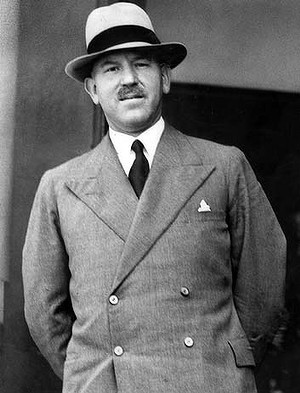
Colonel Eric Campbell, Chairman and co-founder of the Australian Finland Assistance Organization. Campbell would remain active in the Australia-Finland Assistance Organisation throughout the Winter War, working closely and harmoniously with the Finnish Consul, Paavo Simelius and the small but highly professional Valtioneuvoston Tiedotuskeskus Team
In this, he took a low-key approach, but after the Soviet attack on Finland and the subsequent announcement of the setting up of the Organisation, support quickly grew, with membership far surpassing that of the New Guard. It seemed for a while as if every conservative group in Australia had signed up to support Finland – and Colonel Campbell found himself at the apogee of his political career. His life became one of endless travel, speeches and fund-raising campaigns over the length and breadth of Australia. He commented at the time that he thought he had flown on every passenger aircraft in Australia. Within the organization, Campbell’s role, along with Dr. Nott’s, was very much that of the public speaker and motivator.
The small but professional Valtioneuvoston Tiedotuskeskus Team had, behind the scenes, set up a very professional head office structure with a number of different sections focused on media relations, membership, fund-raising campaigns, donations in kind, logistics and transportation, purchasing and the like and staffed largely with very capable volunteers. Colonel Campbell and Dr. Nott supplied the inspiration while the Head Office team supplied the underlying organization and support, with small teams accompanying Colonel Campbell and Dr. Nott on their peregrinations around Australia.
In setting up the nationwide organization, Colonel Campbell, Dr. Nott and their support teams relied heavily on existing organizations – chief among them the large and established Returned Services Association and the Country Womens Association as well as on Colonel Campbell’s still-extent network of former New Guard members and on members of the United Australia Party (UAP) who were, to a man (and woman) remarkably sympathetic to Finland’s plight, as would become evident from the massive support that the Australia-Finland Assistance Organisation engendered. As Chairman of the Organisation, Colonel Campbell was in his element with his fiery anti-Bolshevik speeches and his well-articulated support for the cause of Finland.
Along with Dr. Nott, his name and photo were blazoned across the front pages of the Australian newspapers, his speeches (carefully prepared with professional Valtioneuvoston Tiedotuskeskus editing and input) were quoted extensively, he found himself meeting with leading business and society figures as well as with “honest hard-working Australian patriots” at every stop on his well-orchestrated travels. Already well-known, Colonel Campbell became a household name across the length and breadth of the country, and a name firmly associated with the campaign to support “gallant little Finland.”
The Australia-Finland Assistance Organisation went from success to success, and the departure of Dr. Nott together with the large contingent of Australian Volunteers early in 1940 left Colonel Campbell as the sole leading public figure of the ongoing campaign. The Organisation itself was, by February 1940, firmly embedded in Australian society and the ongoing news of the Finnish successes in the fight against the invading Red Army, together with the first news reports covering the ANZAC Volunteer Battalion and its Australian soldiers, cemented that ongoing support. Australians continued to support Finland, albeit at a lower tempo than that leading up to the departure of the Volunteers, funds continued to be raised, donations collected, news from Finland continued to flow back into the Australian news media.
New Zealand Army volunteer John Mulgan’s regular radio broadcasts “ANZACS in Finland” were listened to in Australia with the same enthrallment as in New Zealand, and indeed across the English-speaking world. With news and photos of the fate suffered by inmates of the Soviet prison camps on the Kola Peninsula and along the length of the White Sea Canal emerging over the summer of 1940, Campbell’s efforts on behalf of Finland would reach a fever-pitch as he condemned the “…outrageous Bolshevik atrocities and mass-murders” and condemned the totalitarian regimes of both German and it’s partner in crime, the Soviet Union.
As the Winter War ended and news of the peace agreement and its clauses regarding refugees and the deportation from the USSR to Finland of the Karelians and Ingrians was communicated, Colonel Campbell and the Australia-Finland Assistance Organisation’s efforts turned to raising funds and sending shipments of aid, primarily civilian clothing, raw materials for the Finnish textiles industry and food for the refugees. Colonel Campbell would continue in these activities through to after WW2, expanding the Organisations role in 1944 and 1945 to include assistance for the peoples of the newly liberated Baltic States and Poland.
In this role, Campbell would speak out vociferously against both Nazi and Soviet atrocities in the Baltic States and Poland and would in fact come to influence Ben Chifley (who had succeeded Curtin as Prime Minister on Curtin’s death in 1945 and who would lead the Labour Party to victory in 1946) on Australia’s foreign policy with regard to the post-war issues regarding the Baltic States, Poland, Finland and the USSR and on immigration from eastern Europe, particularly of the large numbers of refugees who had fled before the advancing Red Army and who were now stateless. It was a strange and unexpected role for the former leader of the “New Guard” but it was one that he embraced wholeheartedly, continuing to be a strong advocate for the admission of large numbers of eastern European refugees to Australia through the 1950’s and up until his retirement in the late 1950’s.
Photo at Left: Ben Chifley, 16th Prime Minister of Australia (1945-1949). Under Chifley, Australia, in the immediate aftermath of World War II, established the Federal Department of Immigration and thereby launched a large scale immigration program under the slogan “populate or perish”. In keeping with policies of the previous governments, Chifley announced a preference for promoting immigration to Australia of mainly British settlers but at the same time, influenced by Campbell, announced that refugees from Eastern Europe as well as immigrants from Finland, Poland and the Baltic States would be accepted. Campbell had convinced Chifley and the Minister for Immigration, Arthur Calwell, that the Eastern Europeans refugees from the Red Army were mostly anti-Communist and so politically acceptable; and that many of them were, like Chifley and Calwell, Catholic.
The British and Eastern European component still remained the largest part of the immigrant intake until 1953. Between 1953 and late 1956, those from Southern Europe outnumbered the British and Eastern Europeans, and this caused some alarm in the Australian government, causing it to place restrictions on Southern Europeans sponsoring newcomers and to commence the “Bring out a Briton” campaign, although Eastern Europeans continued to be accepted with no qualms.
After WW2, Campbell practised as a Solicitor in Young, was president of the Burrangong Shire Council in 1949-50, and bought a property near Yass where he settled in 1957. In 1961 he threatened a libel suit against The Nation (newspaper) for an article on 11 March on the New Guard: no further articles appeared. He published his own account, “The Rallying Point” (Melbourne), in 1965. Next year he moved to Canberra where he practiced law, but his health was increasingly impaired by serious injuries received in an accident in 1959. Survived by his wife, two sons and two daughters, Campbell died of cancer on 2 September 1970 in Canberra and as per his own wish, was buried in a simple family ceremony.
Good-looking, with a neat military moustache, he had a certain panache: in retrospect he had “thoroughly enjoyed” the experience of the New Guard, “the association with so many grand loyal Australians in the Australia-Finland Assistance Organisation” and “helping the people of eastern Europe escape Soviet tyranny and find a new life in a free and democratic Australia.” He was a strong admirer of Ben Chifley, “the disparity of our political views dissipated over the years” and was deeply distressed at his death in 1951. “We sometimes find we have the warmest friendships among people whose politics are not ours. Mr Chifley served this country magnificently for years,” he was quoted as saying.
The Australia-Finland Assistance Organisation
On the 30th of November, 1939, the Soviet Union attacked Finland with no declaration of war. The Valtioneuvoston Tiedotuskeskus team in Sydney had been warned that this was probable and was well prepared, with contacts in the Australian news media by now well established and background information prepared. Immediately the Soviet attacks commenced, telegrams to Valtioneuvoston Tiedotuskeskus teams around the world were dispatched, instructing them to initiate the plans that had been prepared for this eventuality.
Short of any news on the Phony War, the Australian news media splashed the new of the Soviet attack on Finland across the front pages. Along with the front page headlines were a continuous stream of background articles filling the newspapers, describing Finland, setting out the situation, providing a background to the unprovoked attack on a small neutral country which wished only to remain at peace, suggesting ways in which Australians could assist Finland. The immediate Australian public reaction was one of indignation and condemnation of the USSR’s actions. Editorials stridently critical of the USSR blazed across every newspaper in the country. Well-prepared and prominent supporters of Finland spoke on the radio and seemingly overnight, the Australian Finland Assistance Organisation emerged, announced on the 3rd of December 1939 at a packed public meeting in Sydney where the prominent speakers included the joint founders (whom we will cover in the next Post), Dr Lewis Windermere Nott and Colonel Eric Campbell together with the Rev. Kalervo Kurkiala.
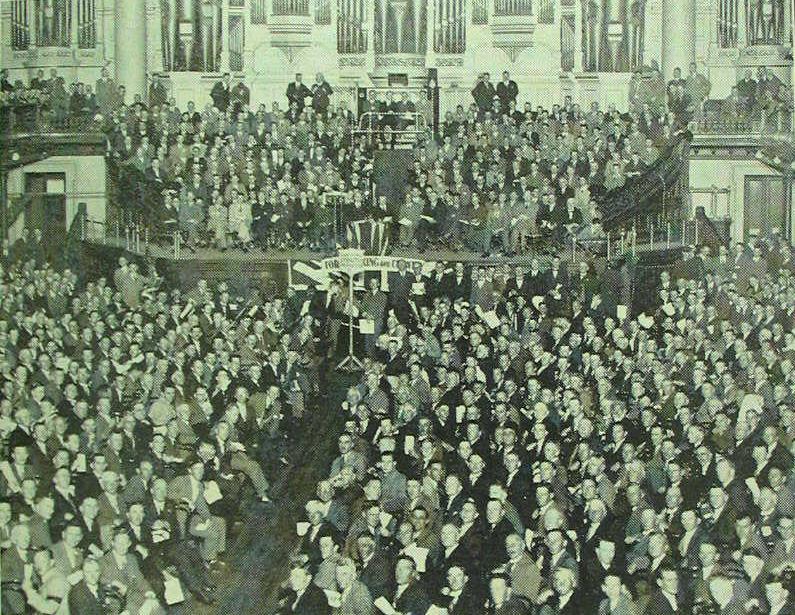
The inaugural meeting of the Australian Finland Assistance Organization in Sydney on the 3rd of December 1939 was packed to capacity
Dr Lewis Windermere Nott and Colonel Eric Campbell had laid the foundations for the Australia-Finland Assistance Organisation well. The day that the war broke out, letters and telegrams began to pour out of the Sydney Office asking those who had indicated their willingness to help to start work immediately whilst newspaper articles nationwide reported the founding of the Organisation and provided contact details for those who wished to setup branches or to join. Within days, branches of the Australian Finland Assistance Organization had been established across Australia, with offices prominently positioned in main streets. Churches, factories, schools, Returned Sailors and Soldiers Imperial League of Australia Halls, the Australian Country Women’s Association, the Australian Red Cross, all were pressed into service as popular enthusiasm led to the organisation’s membership soaring into the thousands within days and into the tens of thousands within a fortnight.
Fund-raising activities commenced almost immediately, with Churchs taking up Collections for Finland, street corner collectors in the cities and large towns, collections in the factory and the office, fund-raising fetes and, on a larger scale, requests to businesses for donations. Within days, thousands of pounds had been collected, within weeks, tens of thousands as the Australian public responded to the call. By mid-December 1939, it seemed that a large percentage of the Australian population were involved in the campaign to support Finland. It was a cause that stirred enthusiasm in the public, far more so than the war with Germany. And this enthusiasm was in large part the result of the skilful and ongoing distribution of information, news articles and commentary provided by the Valtioneuvoston Tiedotuskeskus team.
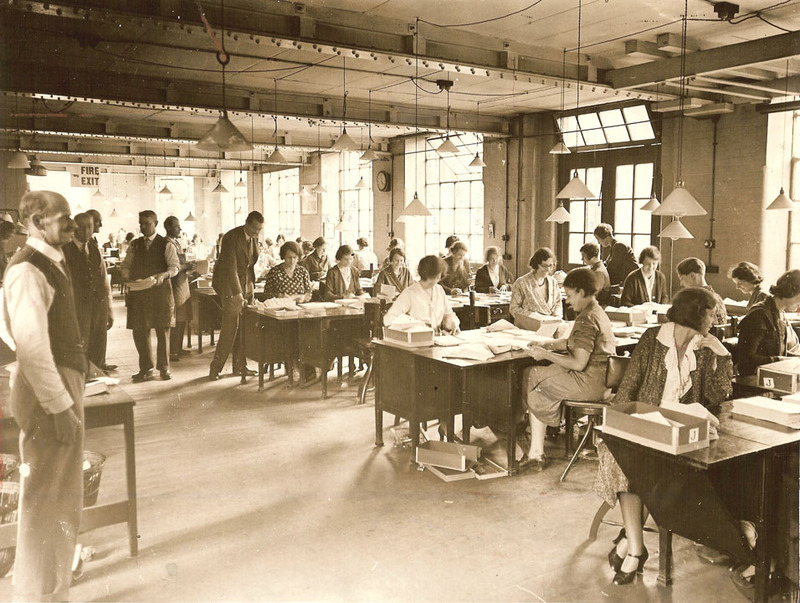
he Head Office of the Australian Finland Assistance Organization was staffed by Volunteers and was a large and meticulously organized hive of industry. The Sydney Finnish community played a large part in the initial establishment of the Office but were soon joined by hundreds of Australian volunteers eager to help the cause of Finland as the Australia-Finland Assistance Organisation rapidly became an “Australia-wide” organization. The small Finnish community would continue to play a strong supportive role in the Organisation in Sydney, working in the Organisation’s Head Office performing the mundane administrative work that any such Organisation needs carried out efficiently in order to be successful.
Two Australian organizations were perhaps the most instrumental in the rapid expansion of support for the Australia-Finland Assistance Organization. These were the Returned Sailors and Soldiers Imperial League of Australia and the Country Women’s Association of Australia, both large and well-organised groups with memberships of well over one hundred thousand and with branches in every city, town and small rural farming community in Australia. Both were also fairly conservative patriotic organizations in all the best senses of the words.
The Returned Sailors and Soldiers Imperial League of Australia was founded in 1916 and had originally been established out of concern for the welfare of soldiers who had served in the military in WW1. As well as arguing for veterans’ benefits, it entered other areas of political debate and was very much politically conservative, with members supporting the British Empire and the King. In most areas of Australia, sub-branches of the League established clubrooms where war veterans could meet and socialise with their old comrades, with the land for the club buildings often donated by the various State governments. The Clubs were generally run on commercial principles and served alcohol and food. They were highly popular with veterans of WW1.
From 1938 on, the RSL began to operate retirement homes for the care of aged veterans. Many RSL members, particularly those who had been officers, had also been members of the New Guard and as such, Colonel Campbell was able to recruit the support of RSL branches and sub-branches across Australia to the support of the Australia-Finland Assistance Organisation. In working to gain the support of the RSL, Valtioneuvoston Tiedotuskeskus would constantly highlight that Finns and Finnish-Australians had fought and died for Australia in WW1 out of selfless patriotism and loyalty to their adopted country. And now, when Finland was in need, Finnish Australians were rallying to support their old homeland, and asking for the support of all Australians to help their country remain free from Soviet tyranny – and the Soviet Union was the ally and friend of Nazi Germany, with whom Australia was officially at war.
Stalin and Hitler were described as but two faces of the same totalitarian enemy whom free peoples around the world were fighting. Much was also made of the way in which Germany under Hitler and the USSR under Stalin had jointly attacked Poland – and now, while Germany attacked Britain, the USSR was attacking Finland. As a returned Finnish-Australian WW1 veteran, Niilo Kara would find himself speaking at fund-raising events throughout New South Wales in support of Finland.
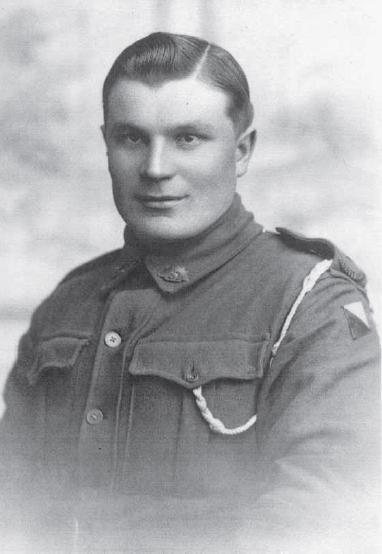
Pihlajaveteläinen Niilo Kara osallistui vapaaehtoisena ensimmäiseen maailmansotaan Australian joukoissa haavoittuen rintamalla. Toivuttuaan hän palasi Australiaan ja toimi jonkin aikaa farmarina. Kuva Siirtolaisinstituutti, Turku / Niilo Kara fought in the First World War as a volunteer in the Australian Army, where he was wounded at the front. After recovering, he returned to Australia and was for some time a station hand (a “station” in the Aussie and Kiwi vernacular is a very large sheep or cattle farm). Picture from the Migration Institute, Turku, Finland
The Australian Country Women’s Association was in some ways the female equivalent of the RSL but was formed out of rather more desperate needs than the desire to socialize and support one’s old WW1 comrades. Rural Australian in the early 1920’s was a large area, and rural women often lived lives of isolation, with an appalling lack of health facilities. The Country Women’s Association was formed in both New South Wales and Queensland in 1922 by women who had to watch helplessly as their children died from minor illnesses. These women realised they had nowhere to turn but to themselves – and the result was staggering.
Within a year, the Association was a unified, resourceful group that was going from strength to strength. The members worked tirelessly to set up baby health care centres, fund “bush nurses”, build and staff maternity wards, hospitals, schools, rest homes, seaside and mountain holiday cottages – and much more. At the same time they continued to run homes in which they were often mother, nurse, teacher and general hand. The women of the CWA, while believing deeply that their role in the family was vitally important, provided social activities and educational, recreational and medical facilities. The CWA expanded into South Australia in 1929 and by 1936 there was a branch in each of the States and Territories of Australia. During the depression years, the CWA helped those in need with food and clothing parcels.
In the late 1930’s, as now, it was the largest women’s organisation in Australia. While Australian newspapers wrote in glowing terms of Finnish bravery as Finland defended itself against the attacker from the East, Australian Finns worked to support their Fatherland. Much had been made in the Australian newspapers of the Lotta Svärd organization and how they supported the Army and the war effort in Finland. In Sydney, Miss Aino Potinkaraa publicly opened a Sydney branch of the Lotta Svärd on the 4th of December and in an interview with the Sydney Morning Herald, spoke about the 30 Finnish women who met every night to knit woollen clothes for the Finnish soldiers and Finnish children.
The news article sparked off a flood of inquiries about establishing similar clubs which were responded to quickly, the net result being similar groups under the aegis of the Australian Country Women’s Association being established across Australia, with the results that we have seen in an earlier post. Within days, Miss Aino Potinkaraa found herself the very public figurehead of the Australian Lotta Svärd, travelling around Australia making speeches at CWA branches, in Churches and at Schools, advising as to how women and schoolchildren could help Finland. Similarly, the Rev. Kalervo Kurkiala, as a Lutheran minister, would speak at both Protestant and Catholic Churches throughout Queensland, New South Wales and Victoria. The Australian Catholic Church was large (in pre-WW2 Australia, Irish Catholics and the descendants of Irish Catholics made up a significant part of the country’s population), influential and was stridently anti-Communist, with the Spanish Civil War having magnified Australian Catholic fears that the Communist menace would spread across Europe.
The Soviet attack on Finland served only as an illustration that these fears were well-founded, albeit Finland was a Lutheran Protestant country rather than a Catholic country. Still, this made little difference to Australian Catholics and the Catholic Church were firmly and whole-heartedly supportive of Finland and of the Australia-Finland Assistance Organisation. The Australian Catholic Church would also throw their political weight behind the increasingly vocal campaign to send Australian volunteers to Finland. A widely circulated newspaper, the “Catholic Worker”, edited by Bartholomew Augustine Santamaria, played a prominent part in Catholic support for Finland.
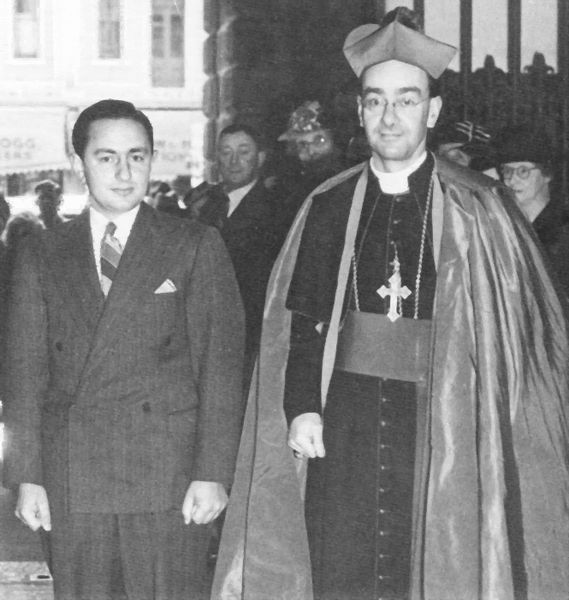
Catholic Archbishop of Adelaide Matthew Beovich with B. A. Santamaria at the first Catholic Action Youth rally in support of Finland, mid-December 1939. Archbishop Daniel Mannix, the acknowledged leader of the Australian-Irish community, was also a close friend and supporter of Santamaria’s.
Photo at Left: Bartholomew Augustine Santamaria (14 August 1915 – 25 February 1998), known as Bob Santamaria, was an Australian political activist and journalist. A highly divisive figure, with strongly held anti-Communist views, Santamaria inspired great devotion from his followers and intense hatred from his enemies. Santamaria was a political activist from an early age, becoming a leading Catholic student activist and speaking in support of Franco’s forces in the Spanish Civil War. He also was a strong supporter and wrote about Mussolini’s regime in Italy, but denied that he had ever been a supporter of fascism. He always disliked and opposed Hitler and Nazism. He attributed Mussolini’s alliance with Hitler to the failed policies of Anthony Eden and expressed regret that Mussolini aligned himself with Hitler. In 1936 Santamaria was one of the founders of the Catholic Worker newspaper and was the first editor of the paper which declared itself opposed to both Communism and Capitalism. In 1937, at the invitation of Archbishop Daniel Mannix, he joined the National Secretariat of Catholic Action, a lay Catholic organisation.
Santamaria was also close to many influential Catholic Labour Party politicians, including Arthur Calwell and James Scullin (who would go on to become Labour Party Prime Minister). Bob Santamaria would strongly support the work of the Australia-Finland Assistance Organisation and would be a leading member and speaker for the Organisation throughout the Winter War and for that matter, through WW2. During WW2he would found the Catholic Social Studies Movement, which recruited Catholic activists to oppose the spread of Communism, particularly in the trade unions. The movement gained control of many unions and brought him into conflict with many left-wing Labor Party members, who favoured a united front with the Communists during the war. During the 1930s and 1940s Santamaria generally supported the conservative Catholic wing of the Labor Party, but as the Cold War developed after 1945 his anti-Communism drove him further away from Labor.
In 1954 H V Evatt, leader of the Labour Party, publicly blamed Santamaria for Labor’s defeat in that year’s federal election, and his parliamentary followers were expelled from the Labor Party. The resulting split brought down the Labor government in Victoria. During the 1960s and 1970s Santamaria regularly warned of the dangers of communism in Southeast Asia, and supported the United States in the Vietnam War.His political role gradually declined. But his personal stature continued to grow through his regular column in The Australian newspaper and his regular television spot, Point of View (he was given free air time by Sir Frank Packer, owner of the Nine Network). A skilled journalist and broadcaster, he was one of the most articulate voices of Australian conservatism for more than 20 years and was greatly admired by conservative politicians. Santamaria had the satisfaction of living to see the fall of the Soviet Union.
Many fund-raising events took place through December 1939 and January 1940. One of the more notables was a series of concerts organized by the Sydney Symphony Orchestra in conjunction with the Australian Broadcasting Company. The guest conductor was Georg Schnéevoigt (8 November 1872 – 28 November 1947), a Finnish musician and conductor who was also a close friend of the great Finnish composer Jean Sibelius. The first concert of the series was graced by the presence of the Governor of NSW, John de Vere Loder, 2nd Baronet Wakehurst and his wife. The program began with the playing of Finland’s national anthem, followed by Sibelius’ Symphony No. 1 E Minor, Opus 39 and after the interval, the Karelian Rhapsody, Palmgren’s “Pastorale” and Sibelius’s Suite “Walse Triste” and finally, Finlandia.
The wife of the Finnish Consul, Mrs. Simelius, also took on a public role with the organization, herself managing the group within Head Office that organized the collection of clothing donations from the Australian people. The volume of clothing collected in this way was large, and the logistical management task was substantial, with large volumes of winter clothing collected or made by volunteers of the CWA being transported by the Australian railways from all around Australia to warehouses in Melbourne from where large groups of volunteers further assisted in sorting and packing for shipment. In addition to funds collected by local branches of the Australia-Finland Asssistance Organisation, donations also poured in to the Head Office in Sydney, with hundreds, and then thousands, of letters arriving daily. All had to be opened, read, donations collected and replies written and posted.
Perhaps fortunately, the Australian Post Office, on the instructions of the Postmaster-General, provided postage free of charge to the organization for both incoming and outgoing mail. Examples included a lady who wrote to the Sydney Morning Herald urging donations to the Organisation’s funds and as an example to others, she sent in £200 to help Finland. A Sydney suburban school sent a letter that read in part: “We’re just little kids, and we do not have a lot of money, but we hope that the 10 shillings we have sent will help to buy bandages for small Finnish children who have been injured.” At the same time, the Australian Government announced it was donating £10 000 to the Finnish Red Cross as a starting point and would match all privately donated monies sent in to the Organisation. The administration of the Australia-Finland Asssistance Organisation’s accounts were entrusted to Sir John Peden, a noted Barrister, Professor of Law and President of the NSW Legislative Council (the Upper House of the New South Wales Parliament, the President of which was the equivalent of the Speaker in the Lower House) from 1929 to 1946 as well as to Lady Kater (appointed as Secretary) and Mr. R. S. Maynard, Treasurer.
In all, the Australian-Finland Assistance Organisation raised funds of slightly more than £1,400,000 (more than 200,000,000 Finnish marks) from public donations. This was of course in addition to donations in kind of food, clothing and the numerous bales of war wool which Australian farmers donated and was matched by the Australian Government. It was a magnificent fund-raising effort for a small country as far removed from Finland as it was possible to be.
Australian Politics and the dispatch of the Australian Volunteers
In Australia, as elsewhere, public opinion had been aroused by the appeal of the Finnish government to the League of Nations for assistance against Soviet aggression, and the subsequent resolution of the Assembly which called upon every member to furnish Finland with all possible material and humanitarian assistance. Typical of the Australian public response was that of a woman in Sydney who signed her letter on December 6th 1939 to the daily newspaper, the Sydney Morning Herald, as “Woman Sympathiser.” She wrote that she had been waiting in vain for some public figure in the Government in Australia to take the lead in standing beside New Zealand in sending help to the heroic Finns. Recognising that it was hard for Australians, in their isolation and with their deep rooted sense of security, to visualize the epic struggle, the woman argued that the Finns were fighting not only for their homes and liberties but for Australia’s as well. Her letter garnered much support and many supporters wrote in a similar vein.
Despite this support, the Menzies Government remained non-committal. The Government’s military advisors did not think that the Finnish Army could hold out against the might of the Red Army and advised the Government that the war would be over before any Volunteers from Australia could reach Finland. However, the news reports from Finland on the fight the Finnish Army was putting up, the large casualties being inflicted on the invading Russians, the early Finnish victories, all fed a demand to send volunteers that was carefully and discretely fanned by the Valtioneuvoston Tiedotuskeskus team. And it wasn’t hard to fan – opinion from the countryside and from the influential Returned Servicemens League was best illustrated by the vitriolic abuse hurled at the Soviet Union by the weekly Bulletin, where the bush ethos and the radical tradition were still served by the pen of Norman Lindsay.
The Catholic Worker, edited by Bob Santamaria, was perhaps not as vitriolic but was certainly equally strident in it’s call for the dispatch of Volunteers. Within the pages of the media, there was little opposition to the calls to support Finland. The main opposition to these calls would come only from the small Communist Party of Australia and its leader, Lance Sharkey.
Lawrence Louis “Lance” Sharkey (1898 – 1967) joined the Communist Party in 1924 and emerged in 1928 as a strong advocate of the Comintern line when he was elected to the CPA’s governing Central Committee. In 1929 he was appointed editor of the party newspaper “Workers’ Weekly” and would edit that paper and another party publication, “The Tribune”, through the 1930s. He became Chairman of the CPA in 1930 and would hold the post until 1948 (from 1948 to 1965 he served as the Secretary-General of the Party – closely following the prevailing Soviet line in each major turn of policy). In the summer of 1930 Sharkey visited the Soviet Union for the first time.When Prime Minister Sir Robert Menzies declared the CPA illegal in June 1940, Sharkey and other party leaders went underground. A year later when Nazi Germany invaded the Soviet Union, the ban on members of the CPA was relaxed and Sharkey resumed open political activity. In March 1949 Sharkey told a Sydney journalist that “if Soviet Forces in pursuit of aggressors entered Australia, Australian workers would welcome them.” For this statement Sharkey was tried and convicted of sedition. The High Court upheld his conviction; and in October he was sentenced to three years’ imprisonment. He remained prominent in the Australian Communist Party where he minimised Khrushchev’s repudiation of Stalin in 1956 and the Soviet invasion of Hungary later that year.
He died of a heart attack on 13 May 1967 in Sydney. In January 1940 Sharkey explained the facts as Australian communists saw them. Finland had been ruled by Mannerheim’s clique for twenty years. The clique had come to power at the point of the bayonets of German imperialism which had overthrown the socialist government that the workers had established in Finland during the course of the Russian revolution, murdering between 30,000 and 50,000 Finnish and Russian workers in the process. Australian communists were told that Mannerheim had established a White Terror Dictatorship in which the Communist Party was suppressed and trade union recognition was illegal until the last hours before the War. The government of Kuusinen was, by this account, the legitimate successor to the government of the Finnish People which had been overthrown by the bayonets of Mannerheim and Von Der Goltz in 1920. Sharkey argued that the Finnish White Guards were the mortal enemies of the Soviet Union and stressed that Finnish Reaction was dangerous because it was a puppet of world imperialism, a dagger in the hands of British, French and German imperialism. It was a danger because the Finnish terrain, in the hands of a strong Army, would make it a most powerful military base, especially as Finland commanded the approaches to Leningrad and Murmansk.
The Finnish White Guards, added Sharkey, could have had a treaty with the Soviet Union on the same terms as the three Baltic States. This they had refused, believing in the support of British and French imperialism and, behaving provocatively, even firing on Soviet troops. Sharkey concluded by describing the Finnish negotiations with the Soviet Union as sabotage. But he was glad to report that the mutual assistance treaty between Kuusuninen’s Finnish Government and the Soviet Union made Finland and the Soviet Union secure from attack (noting in passing that the capitalist rulers of Finland are of Swedish extraction), and he comprehensively predicted that the toiling people of the whole world would rejoice at the liberalization of their brothers in Finland, and would spit on the lies of capitalism, the millionaire press, the labour imperialists and the Trotskyite hirelings. That this of course did not fly with the Australian public is more or less needless to state. The only believers were the credulous supporters of the official Communist Party line and these were few and far between.
In Australia, the question of raising Volunteers to fight in Finland unsurprisingly received a great deal of public support. The substantial and nation-wide network of voluntary organizations that had sprung up to raise money and collect aid for Finland had, as it had in many other countries also, taken on a life of it’s own. The news media fed the public mood with continued stories of the heroic fight being put up by the Finns and the stories of the early volunteers (and in Australia and New Zealand in particular, the rapid dispatch in late December 1939 to the frontlines of the ANZAC Volunteer Battalion). The news that New Zealand, Australia’s minuscule neighbour in the South Pacific, was planning to dispatch a second volunteer Battalion to Finland acted like bait to a Great White Shark as far as Australian public opinion was concerned.
The debate grew heated, the editorial pages in the Australian newspapers castigated the Australian government for a lack of support for a small fellow-democracy fighting for its life and used the dispatch of TWO volunteer battalions from tiny New Zealand as a whip with which to lash the Menzies Government – whom they were already criticizing for not dispatching troops of the Australian Imperial Force to Europe to fight with the British Army in a timely manner. It is idle to suppose that government in Australia took no notice of public comment. Response to public opinion was a cornerstone of the Westminister style of government, and the Menzies administration took criticism seriously enough to look at the Winter War in Cabinet. H.S. Gullet briefed the Cabinet on facts and information necessary for them to deliberate on the question of aid for Finland.
The obvious vital issue was whether aid to Finland should be confined to humanitarian assistance or whether Australia should also offer military assistance. The first action taken, on the 10th of December, was that in light of the strong Australian support for Finland, the Government would match all private donations made to the Australian-Finland Assistance Organisation on a one for one basis. Cabinet was also advised that the Finnish Government had been advised that all orders placed for the purchase of non-armament related items would be approved without hesitation. It was spelled out in some detail to the Cabinet as to what these orders consisted of and that these did not threaten in any way the ability of Australia to support the war against Germany. This information was passed in code to the Australian High Commissioner in London, who was instructed to inform the United Kingdom Government and the Finnish Government.
Gullett also recommended to the Cabinet that they send the League of Nations a telegram stating that Australia was fully in accord with the resolution expelling the Soviet Union from the League, and was prepared to offer Finland such assistance as was practicable. The Cabinet also approved these actions. Once the decision to permit fund raising, donations and the selling of goods to support the Finnish war effort was approved, the Australia-Finland Assistance Organisation and their supporters began to press their claims harder. The pressure came from two distinct quarters: from medical practitioners who wished to man field hospitals in Finland, and from Australians who wished to fight there.
Dr Lewis W. Nott, a medical practitioner, former member of the House of Representatives and one of the founders of the Australia-Finland Assistance Organisation was foremost among those trying to organize a Field Hospital and medical units for the Winter War. He wrote a series of letters to the Prime Minister and to the daily press in which he pointed out that in Britain organized recruiting was going on for military as well as medical aid for stricken Finland. Following the governments substantial commitment to Finnish Aid, Nott asked whether the Prime Minister would give his imprimatur to the ambulance and medical units and field hospital that Nott was organizing. There were, Nott said, many professional men like himself, who though medically fit, and with excellent civil and military records, were not allowed to go overseas with the second A.I.F. (Australian Imperial Force).
Following his first article in a Sydney newspaper offering to organize the field hospital, medical and ambulance units, Nott was inundated by an overwhelming response from surgeons, specialists, dentists and nurses from all states, even as far afield as North Queensland, South Australia and Western Australia. In a further article the following day, Dr. Nott pointed out that Australia’s fate was inextricably bound up with that of Finland, and Finland’s “Gallant Resistance” was an inspiration to democracy at its intelligent best. There was, Nott repeated, not one obstacle in the path of staffing the Unit at once, but the question of transport, stores and upkeep was the major consideration. Nott could only visualize the unit succeeding by a combination of government and voluntary assistance. Even as Dr. Nott led the campaign, the Australia-Finland Assistance Organisation, with the assistance of retired, reservist and militia officers, put together the proposed medical units and assessed and signed up Volunteers to serve in them should approval be given.
A parallel campaign was also underway supporting the dispatch of a Volunteer contingent to Finland. This aspect of the campaign was spearheaded on the one hand by Colonel Campbell, and on the other by a Mr. Charles C. K. Foot, of Western Australia. The point was made that the crucial test of Australian intentions in the fight against totalitarianism in all its guises was the issue of whether Australian volunteers would be permitted to go to Finland to fight. Traditionally Australians had been quick to volunteer and there was a long tradition also in effect by which all service overseas was voluntary. Australian volunteers had been among the first to fight in the Boer War in South Africa at the end of the nineteenth century. In 1914 they enlisted in droves to volunteer for overseas service. The view that men needed to be conscripted for overseas military service split the nation as the First World War dragged on, and there was a hard dying tradition that the need would find the men.
Therefore it was hardly surprising that Australians should volunteer by the thousand to fight in Finland – and the Australian newspapers continually pointed out that hundreds of men every day were writing or visiting the Assistance Organisation’s offices and signing up as Volunteers to fight. Colonel Campbell and Charles Foot pleaded their cause, with the at times strident support of every newspaper in Australia. Even the Labour Party opposition joined the chorus, perhaps influenced by their large Irish Catholic constituency and the support of such articulate activists as Bob Santamaria. The War Cabinet first debated the issue at its meeting in Melbourne on 20 December 1939. Gullet introduced the agenda item with a brief sketch of Finlands appeal to the League of Nations, and the Leagues request for clarification of the Australian Governments intentions.
Gullets information was that while the United Kingdoms reply to the Secretary General of the League merely stated that it would give “such assistance as was practicable”, the government was assisting materially with the provision of aircraft, anti-aircraft and artillery guns and ammunition. Further, Gullett had been informed that the United Kingdom was already in the process of considering the dispatch of Volunteers and that the UK and France had also jointly made proposals to both Norway and Sweden that, in the event of their rendering every possible assistance to Finland and as a consequence themselves becoming involved in hostilities, Great Britain would be prepared to consider what assistance it could give to these countries. The Cabinet further considered the sending of volunteers on the next day. H. S. Gullett pointed out the legal difficulties. The British Foreign Enlistment Act of 1870 made it unlawful for a British subject to enlist in the military or naval service of a foreign country which was at war with a state at peace with His Britannic Majesty.
This Act applied to Australia, and had been invoked at the time of the Spanish Civil War to prevent Australians from leaving the country to join the International Brigades. There was however, Gullett admitted, provision in the 1870 Act for the King to grant a license which would permit British subjects to enlist and help Finland. Gullett recommended however that no action be taken over Australian Volunteers for Finland. He pointed out that apart from the obvious practical difficulties and the need for concentration on the official Australian war effort. He also stated that it was doubtful whether any effective assistance to Finland could be provided as it would be months before volunteers from Australia could have received adequate training and reached Finland, and by that time the question of Finlands ability to resist Russian aggression would in all likelihood have been decided. On the information Gullett had at that time it appeared that unless Finland received Allied help on a substantial scale in the near future she would be compelled to sue for peace. If the Allies decided that they were not in a position to give such help, the sending of Australian volunteers would serve no useful purpose. The Cabinet agreed with Gullett to postpone a decision on the matter and further consider it in the New Year.
Sir Henry Somer Gullett KCMG (26 March 1878 – 13 August 1940) was an Australian Cabinet Minister and member of the House of Representatives. After leaving school, he worked as a journalist, writing for newspapers. In 1908 he travelled to London where he also worked as a journalist and in 1914 published a handbook on Australian rural life, The Opportunity in Australia to promote emigration to Australia. In 1915, Gullett became an official Australian correspondent on the Western Front. In July 1916, he joined the first Australian Imperial Force (AIF) as a gunner.
From early 1917 he worked with Charles Bean collecting war records and later with the AIF as a war correspondent in Palestine. In 1919, he was briefly director of the Australian War Museum. He started writing volume VII of The Official History of Australia in the War of 1914-1918, covering the Sinai and Palestine Campaign, which he completed in 1922. In 1920, Billy Hughes (the Australian Prime Minister at the time) appointed him head of the Australian Immigration Bureau. He won a seat in Parliament for the Nationalist Party in 1925 and held it until his death in August 1940. In April 1939, Gullett became Minister for External Affairs in the first Menzies Ministry and Minister for Information from September 1939. He met with the Finnish Consul, Paavo Simelius a number of times in the weeks preceding the outbreak of the Winter War, and rather more frequently thereafter up until his death. He tended to defer to the Australian High Commissioner in London, the previously mentioned Stanley Melbourne Bruce, on matters of Foreign Affairs – and Bruce regarded the Russo-Finnish war in general as an unwelcome distraction which Australia should best avoid entanglement in.
However, the Press and the Public were not to be denied and the public campaign orchestrated by the Australia-Finland Assistance Organization grew every more vociferous and intense. The headlines of the major newspapers grew ever more critical of the Government, steps by which Volunteers could reach Finland and join the fight were articulated, Members of Parliament were pressured by their constituents and questions began to be asked. The official Opposition, the Labour Party, stepped into the fray in support of the dispatch of Volunteers. “Not a token force, but a substantial number of Volunteers who can make a real difference” stated Scullin. In this, many members of the Labour Party had been influenced by the strongly stated views of Bob Santamaria.
Within the governing coalition, many MP’s, pressured by their constituents, began to press for approval and support for the dispatch of a Volunteer Force. Spurred on by the increasingly bad press the Government was receiving, the Australian Prime Minister, Robert Menzies made the decision, publicly announced in early January 1940, that two Battalions of Australian Volunteers together with supporting troops and a Field Hospital and Ambulance Unit would be raised and dispatched to Finland – and that this would occur within days. Dr. Lewis Nott was placed in charge of all medical units to be raised and it was stated that volunteers would be accepted from both Regular Officers, the Citizen Force and the A.I.F as well as from civilians.
The implication was made that preparations had been underway for some time but the need for secrecy had meant that the public could not be informed until certain preparatory actions had been taken. This was of course nonsense, but it served to assuage the media and the public. Menzies’ announcement stated that in the interests of speedy and large-scale assistance to Finland, men without prior military training would be accepted and that Volunteers from the AIF and the Militia could apply through the Australia-Finland Assistance Organisation. The Organisation of course had no real capability in place to handle such recruiting and processing of volunteers and the situation moved rapidly towards farcical. Menzies however, was not Prime Minister of Australia for nothing.
Army Headquarters were instructed to second Officers and NCO’s to the Australia-Finland Assistance Organisation and carry out the assessment and selection of Volunteers, who were to be gathered in Melbourne for dispatch by sea within a fortnight. Organisation of the men into units would take place in Melbourne prior to departure. The Army Command, taken completely by surprise and not consulted by Menzies before his announcement and his demands on the Army, scrambled to put some sort of structure in place to deal with what was now a fait-accompli – particularly as Menzies had made it more than plain that this was something that needed to be seen to be done quickly and efficiently. At the same time, rapid decisions needed to be made on the size of the Volunteer unit, the numbers of men to be sent, equipment to be provided, shipping, and all the minutiae of dispatching a small and self-contained military force that politicians take for granted when they make political decisions regarding military matters.
The miracle was that the Australian Army succeeded. Exactly two weeks from Menzies’ announcement, a small convoy of Finnish merchant ships, some of them hastily converted into rudimentary troop ships, departed Melbourne unescorted with some 5,150 volunteers jammed on board but with no equipment other than a few hundred old Lee-Enfield .303 Rifles. The Australian Army had no artillery, mortars, AA guns or Anti-Tank guns to speak of, very few machineguns and there was a shortage even of the old .303 Rifles. In the short time between the announcement of the volunteer force and departure, a flurry of telegrams took place between Australia and Finland, the result of which was that the Finns were to arm and equip the Australians (and indeed, the Commonwealth Division) from their war reserves.
This would mean that the Commonwealth Division would more than likely go into battle using the old Mosin-Nagant Rifles that the Maavoimat had been replacing as fast as possible with the newer semi-automatic Lahti-Salaranta SLR. The Australian Government howevever, was more concerned with getting the volunteers on their way than in how the Finns would manage to provide them with weapons and equipment (although the ladies of the CWA did ensure the volunteers were plentifully equipped with warm clothing, coats, hats, scarves, mittens and felt-lined boots. They might have no rifles or machineguns, but at least they would be warm in their Australian woollies).
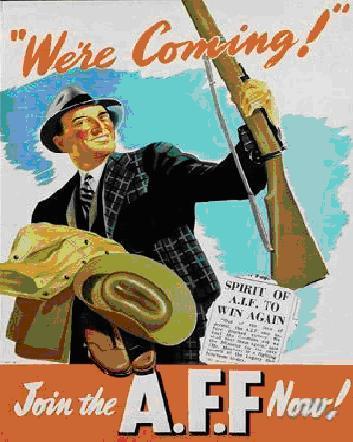
Recruiting Poster for the Australian Finland Force – “Join the A.F.F. Now!” The recruiting poster depicts a happy young man in civilian clothes, holding an Army uniform and rifle, the newsclip in the background refers to the fighting prowess of the Australian Infantry. Such was the popularity of the cause that there were three times as many Volunteers as places, the standard of selection was thus high.
The announcement that volunteers were actually being dispatched aroused the patriotic fervour of the Australian people – and the Australia-Finland Assistance Organisation found itself flooded with more volunteers than could be handled and further donations of money and materials. At the same time the Australian Government stating that the Government was committed to paying outright for all travel costs, the provision of uniforms as well as paying an allowance to the Volunteers – which were in fact the majority of the costs). As mentioned in an earlier post, Ford Australia very publicly donated 250 Ford trucks at cost straight of the Geelong Assembly line and had these crated for shipment to Finland, together with 50 Ambulances which were donated outright, with the fitting out as specialist Ambulance trucks being carried out by Ford workers on a voluntary basis.
The Australian Pharmaceutical and Medical Supplies industry provided large quantities of medical and pharmaceutical supplies at cost and these were transported to Melbourne by the Railways free of charge where they were sorted and packed by volunteers. In addition to the shiploads of Volunteers and accompanying military and medical cargo, shiploads of Australian wheat, frozen mutton and lamb and canned meat were dispatched, paid for by the Assistance Organisation. The Finnish ships would proceed together as a small convoy to Cape Town and thence to the UK, where they would be routed to a suitable port in Norway for unloading. The Volunteers would take seven weeks by sea to reach Petsamo, arriving in late March 1940.
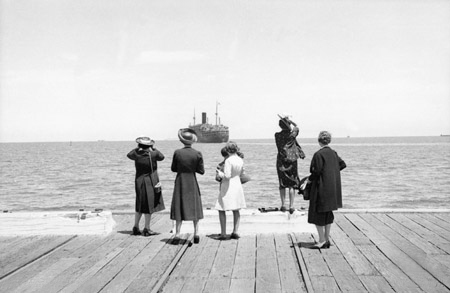
Five women bid farewell to one of the last troop ships carrying the Australian Volunteers as it leaves Melbourne in late January 1940, bound for Finland.
With the dispatch of the Volunteers to Finland, the Australian Government breathed a great sigh of relief and turned its collective attention back to the “real” war. Public opinion was assuaged. The newspapers praised the decisiveness of the Prime Minister and the War Cabinet, then continued to report on the progress of the Russo-Finnish War and on the ANZAC Volunteers already in Finland. The Australia-Finland Assistance Organisation continued its work, albeit at a lesser pitch of fervor and intensity.
 Copyright secured by Digiprove © 2013 Alternative Finland
Copyright secured by Digiprove © 2013 Alternative Finland


